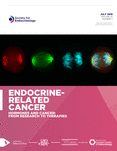Notch pathway inhibition targets chemoresistant insulinoma cancer stem cells
- 1Royal (Dick) School of Veterinary Studies and The Roslin Institute, University of Edinburgh, Midlothian, UK
- 2Department of Clinical Sciences of Companion Animals, Faculty of Veterinary Medicine, Utrecht University, Utrecht, The Netherlands
- 3Hill’s Pet Nutrition, Topeka, Kansas, USA
- Correspondence should be addressed to Y Capodanno: ylenia.capodanno{at}roslin.ed.ac.uk
Abstract
Insulinomas (INS) are the most common neuroendocrine pancreatic tumours in humans and dogs. The long-term prognosis for malignant INS is still poor due to a low success rate of the current treatment modalities, particularly chemotherapy. A better understanding of the molecular processes underlying the development and progression of INS is required to develop novel targeted therapies. Cancer stem cells (CSCs) are thought to be critical for the engraftment and chemoresistance of many tumours, including INS. This study was aimed to characterise and target INS CSCs in order to develop novel targeted therapies. Highly invasive and tumourigenic human and canine INS CSC-like cells were successfully isolated. These cells expressed stem cell markers (OCT4, SOX9, SOX2, CD133 and CD34), exhibited greater resistance to 5-fluorouracil (5-FU) and demonstrated a more invasive and tumourigenic phenotype in vivo compared to bulk INS cells. Here, we demonstrated that Notch-signalling-related genes (NOTCH2 and HES1) were overexpressed in INS CSC-like cells. Protein analysis showed an active NOTCH2-HES1 signalling in INS cell lines, especially in cells resistant to 5-FU. Inhibition of the Notch pathway, using a gamma secretase inhibitor (GSI), enhanced the sensitivity of INS CSC-like cells to 5-FU. When used in combination GSI and 5-FU, the clonogenicity in vitro and the tumourigenicity in vivo of INS CSC-like cells were significantly reduced. These findings suggested that the combined strategy of Notch signalling inhibition and 5-FU synergistically attenuated enriched INS CSC populations, providing a rationale for future therapeutic exploitation.
- Received 7 November 2017
- Accepted 24 November 2017
- Made available online as an Accepted Preprint 24 November 2017
- © 2018 Society for Endocrinology












